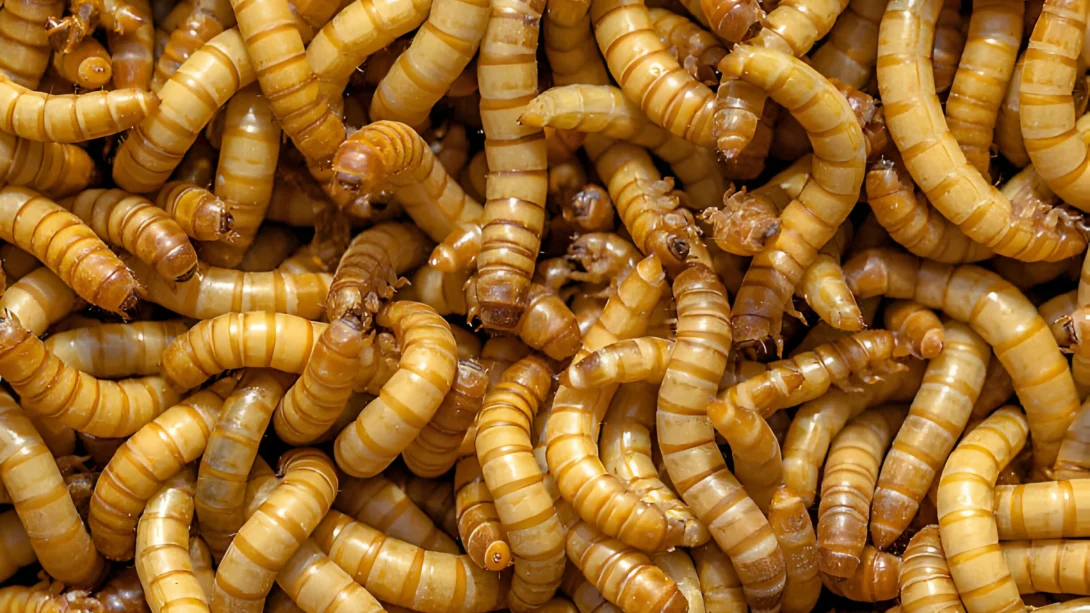Mealworms, the larval form of the mealworm beetle, Tenebrio molitor, are common pests in homes, gardens, and anywhere they can find their preferred diet of stored grains and decaying plant matter. While not harmful to humans, their presence can indicate and contribute to unsanitary conditions, and they can cause significant damage to stored food and pet supplies. Understanding how to effectively manage and eliminate mealworm infestations is crucial for maintaining a clean and healthy environment.
Identifying Mealworm Infestations
Mealworms are typically about 1/2 to 3/4 inch long, with a cylindrical, segmented body that’s golden to dark brown in color. They are most commonly found in areas where food is stored, especially grains, cereals, and pet foods. Signs of an infestation include the visible presence of mealworms themselves, their molted skins, and the dark, small beetles they mature into.
Mealworms
The lifecycle of a mealworm progresses from egg to larva (the stage commonly recognized as the mealworm), to pupa, and finally to the adult beetle. This cycle can take anywhere from a few months to over a year, depending on environmental conditions such as temperature and humidity. Understanding this lifecycle is key to effective mealworm control, as interventions can be targeted at specific stages for greater impact.
Mealworms are drawn to damp, dark, and warm environments where there is an ample supply of food. In homes, this often means kitchens, pantries, and anywhere grains or pet foods are stored without adequate protection. In gardens, they tend to be less of a direct problem for live plants but can indicate compost or mulch that is too moist or dense.
Preventive Measures
Prevention is the most effective strategy against mealworm infestations. Here are several measures to reduce the risk:
- Storage Solutions: Store grains, flour, cereal, and pet food in tightly sealed containers. This not only prevents mealworm access but also makes it easier to isolate any infestations that do occur.
- Regular Cleaning: Clean pantry shelves, pet feeding areas, and storage spaces regularly to remove food debris and potential mealworm eggs. Vacuuming and wiping down surfaces with a vinegar solution can deter pests.
- Inspect Purchases: Carefully inspect grains, cereals, and pet foods for signs of mealworms before bringing them into your home. Infestations often start with infested items from the store.
- Proper Composting: In gardens, ensure compost heaps and mulch are not overly moist and have adequate aeration to discourage mealworms and other pests.
Natural Remedies and Solutions
When dealing with mealworms, many prefer starting with natural and non-toxic methods to avoid harming pets, beneficial insects, and the environment. Here are several effective natural remedies:
- Diatomaceous Earth (DE): A fine powder made from the fossilized remains of algae, DE can be sprinkled around areas where mealworms are found. It works by dehydrating the insects upon contact. Ensure to use food-grade DE, especially around pets and food storage areas.
- Natural Predators: In outdoor settings, encouraging the presence of natural predators can help control mealworm populations. Birds, frogs, and certain types of beetles prey on mealworms and can be attracted to your garden with the right habitat features, such as birdhouses and water sources.
- Temperature Control: Mealworms thrive in warm conditions. Refrigerating or freezing susceptible food items for at least 48 hours can kill any eggs or larvae present. This is particularly useful for bird seed, pet food, and grains that are stored for long periods.
Chemical Control Options
In cases where natural remedies are insufficient to manage a mealworm infestation, chemical pesticides may be necessary. However, caution is advised to minimize exposure to non-target species and areas:
- Insecticides: Select insecticides that are specifically labeled for use against mealworms and safe for the intended application area. Always follow the product’s instructions regarding application rates and safety precautions.
- Boric Acid: A less toxic chemical option, boric acid can be effective against mealworms when applied to cracks, crevices, and other hiding places. It acts as a stomach poison and desiccant, leading to dehydration and death of the insects.
- Ivermectin: For pet enclosures, especially those housing birds or reptiles, ivermectin-based products can be effective. Consult with a veterinarian for appropriate use and dosage to ensure the safety of pets.
Cleaning and Sanitizing Infested Areas
Once mealworms are identified, thoroughly cleaning and sanitizing the affected areas are crucial steps in eradication:
- Remove Infested Items: Discard heavily infested food items in sealed containers to prevent spreading. Lightly infested items can be salvaged by freezing or heating to kill any mealworms.
- Vacuum and Clean: Vacuum shelves, drawers, and storage areas thoroughly to remove mealworms, eggs, and debris. Follow up with a disinfectant cleaner to sanitize surfaces and eliminate any lingering eggs.
- Seal Entry Points: Mealworms can enter homes through very small spaces. Seal cracks and crevices in pantry areas, baseboards, and around windows and doors to prevent entry.
Managing Mealworms in Pet Enclosures
Pet enclosures, including those for birds, reptiles, and small mammals, can be particularly vulnerable to mealworm infestations due to the presence of feed and bedding materials that provide ideal breeding grounds. Here are some targeted strategies for pet owners:
- Regular Cleaning: Clean and sanitize pet enclosures regularly. Remove and replace bedding and feed substrates frequently to disrupt the mealworm lifecycle.
- Isolate New Supplies: Before introducing new bedding or feed into the enclosure, freeze or thoroughly inspect it to ensure it’s free of mealworms and other pests.
- Use Safe Treatments: If chemical treatments are necessary, opt for pet-safe options and consult with a veterinarian beforehand. Natural deterrents like diatomaceous earth can also be used around pet enclosures, but always ensure they are not inhaled by pets or placed where pets might ingest them.
Monitoring and Long-term Management
The key to a mealworm-free environment is ongoing vigilance and preventive measures. Implementing a routine monitoring system can help catch new infestations early:
- Regular Inspections: Periodically inspect storage areas, pantries, and pet enclosures for signs of mealworms. Early detection makes control efforts more manageable and less invasive.
- Maintain Cleanliness: Continue practicing good hygiene and storage habits to make your home and garden less attractive to mealworms. Regularly clean pet areas and store foods in sealed containers.
- Review and Adjust: Periodically review the effectiveness of your control and prevention strategies. Be prepared to adjust tactics if mealworms reappear or if certain methods prove ineffective.
Conclusion
Mealworms, while not harmful to humans, can cause significant damage to stored foods and create unsanitary conditions in homes and gardens. By understanding their lifecycle and implementing a combination of preventive measures, natural remedies, and, when necessary, chemical treatments, you can effectively control and eliminate mealworm infestations. Regular cleaning, vigilant monitoring, and adopting safe practices for pet enclosures are crucial for maintaining a healthy, mealworm-free environment. Remember, the most successful pest management strategies are those that are proactive rather than reactive, focusing on prevention as the first line of defense. With the right approach, you can protect your home, garden, and pets from the unwelcome intrusion of mealworms.



